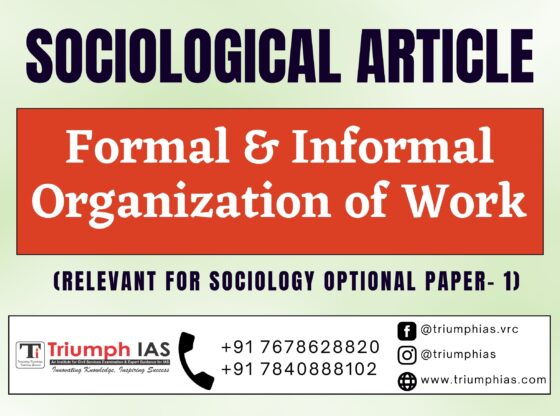Formal & Informal Organization of Work
Relevant for sociology optional Paper- 1 (Unit- 6 : Sociology- Works & Economic Life)

The organization of work can be classified into two distinct categories: formal and informal. Formal organizations are structured, hierarchical, and often bureaucratic, while informal organizations are characterized by fluid, flexible, and often unspoken rules and norms. Understanding the differences between these two types of organization is essential for understanding the dynamics of work and the ways in which work is structured and coordinated.
Formal organizations are typically characterized by a clear hierarchy of authority and a division of labour that is designed to achieve specific goals and objectives. These organizations are often characterized by a strict chain of command, with each employee reporting to a higher-ranking individual who is responsible for their performance and productivity. Formal organizations are typically large, complex, and bureaucratic, with rules and regulations that govern nearly every aspect of work life.
One of the key features of formal organizations is the separation of roles and responsibilities. In these organizations, tasks and responsibilities are assigned based on job descriptions, with each employee expected to perform a specific set of duties within a predetermined set of guidelines. Formal organizations are often designed to be efficient and productive, with a focus on achieving specific goals and objectives in the most effective manner possible.
The formal organization of work is often seen in large corporations, government agencies, and other large organizations. These organizations often have strict hierarchies of authority, with a clear division between management and employees. They are often characterized by a formal dress code, strict working hours, and an emphasis on punctuality and productivity.
On the other hand, informal organizations are typically characterized by a lack of formal structure or hierarchy. In these organizations, roles and responsibilities are often fluid and flexible, with individuals taking on multiple roles and responsibilities based on their skills and interests. Informal organizations are often based on relationships, trust, and shared interests, rather than formal job descriptions or hierarchies of authority.
One of the key features of informal organizations is the importance of social networks and personal relationships. These networks and relationships are often based on shared interests, hobbies, or other non-work-related activities. In these organizations, individuals may work together to achieve shared goals, even if they do not have a formal job title or role.
Informal organizations are often seen in small businesses, start-ups, and other entrepreneurial ventures. These organizations are often characterized by a more relaxed work environment, with fewer formal rules and regulations. Employees may have more autonomy and flexibility in their work, and may be encouraged to take on multiple roles and responsibilities to help the organization achieve its goals.
While formal and informal organizations may seem to be diametrically opposed, they are often complementary and can coexist within the same workplace. For example, a large corporation may have a formal hierarchy of authority, but may also encourage informal networks and relationships among its employees. Similarly, a small business may have a more informal work environment, but may still have a clear division of labour and specific roles and responsibilities.
Understanding the differences between formal and informal organizations of work is essential for understanding the dynamics of work and how work is structured and coordinated. Formal organizations are often designed to be efficient and productive, with a focus on achieving specific goals and objectives. Informal organizations, on the other hand, are often based on relationships, trust, and shared interests, and may be more flexible and adaptable to changing circumstances.
In conclusion, the organization of work can be classified into two distinct categories: formal and informal. Formal organizations are structured, hierarchical, and often bureaucratic, while informal organizations are characterized by fluid, flexible, and often unspoken rules and norms. While these two types of organization may seem to be at odds with each other, they can coexist within the same workplace and may complement each other in achieving shared goals and objectives. Understanding the differences between formal and informal organizations of work is essential for understanding the dynamics of work and how work is structured and coordinated. By recognizing the benefits and limitations of each type of organization, employers can make informed decisions about how to structure and manage their workforce, as well as how to foster positive working relationships and a healthy workplace culture. It is important to recognize that each type of organization has its own strengths and weaknesses, and that a combination of formal and informal structures may be the most effective approach for certain organizations and situations. Ultimately, understanding the dynamics of formal and informal organizations of work can help employers and employees alike to create a more fulfilling and successful work environment.
For more such notes, Articles, News & Views Join our Telegram Channel. https://t.me/triumphias
Click the link below to see the details about the UPSC –Civils courses offered by Triumph IAS. https://triumphias.com/pages-all-courses.php


